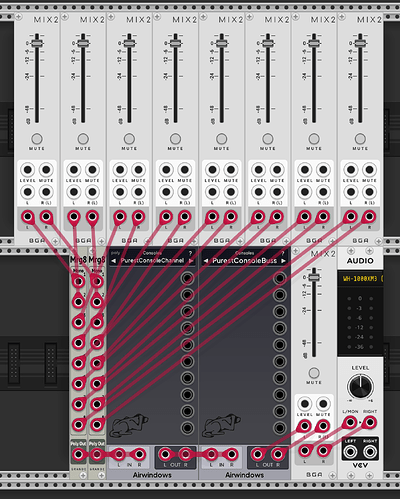AW Console specifically needs unity gain between the encoders and the decoders. So yeah post fx should be enough afaik.
The thing we need post-fader effects for isn’t “emulating an analog console” per se: we need it to change the way digital summing works, or rather to make doing so more ergonomic. This is what PurestConsole does. (The other AW consoles give even more vibes by also adding coloration.) The way it does this is by applying an invertible function (sin) as the last effect on the channel with the Channel effect and inverting it (asin) as the first effect on the summing buss with the Console effect. Since digital summing happens in between, this changes the way summing works (since asin(sin(a) + sin(b)) != asin(sin(a+b)). For it to work properly, there can’t be any processing between the encoder and the decoder, including gain changes. This doesn’t actually “emulate an analog console”, since analog summing doesn’t do the sin/asin thing, but it does change the behavior of digital summing in a subtle and pleasant way.
The easiest way to do this is with post-fader effects, because otherwise you can’t use the fader. If you don’t have post-fader effects, you have two options: you can use a gain tool before the encoder or group each track and apply the encoder to the parent track. Both are annoying.
The sin/asin trick is a brilliant idea from Chris, in part because it’s so simple that you can implement it in a mixer with literally two lines of code. Who will be the first?
Playing devil’s advocate here to an extent, but I’d be genuinely interested to know how many people could hear the difference.
I’m with you on that one. It seems that a lot of energy of being expended for little results.
@rein.henrichs
as I’m not a programmer nor a mastering engineer I may not really understand you.
Could you provide a real world example that makes it clear to illiterate people like me to understand the difference / advantage of your idea?
best would be if you could provide a VCV patch that would show of the difference you explained.
As I understand you, it would be possible to do it now, but it is not as convenient as it could be.
Maybe I’m totally wrong …
I have noticed that some Airwindows effects are very sensitive to input gain, and may distort (in a bad way) if the input is too high (close to 0db). It’s not a problem at all, just a precaution to use gain staging before the effect to achieve the best results. This is not often done in Rack (or I’ve never really bothered with gain staging in Rack), But -6 to -12db seems to be the sweet spot. Otherwise I’m absolutely loving it. Thanks so much for making this plugin!!
I suppose in a future version I could use an input gain reduction maybe an rmb or perhaps a small knob between the inputs
I convert 5v to 1.f which is the vst standard for 0db and yeah most daws have gain below rhst. Excellent observation
Yep the levels don’t seem consistent across different effects. I’ve noticed some crackling when modulating parameters on some effects too, particularly in poly mode. Not complaining though, it’s a fantastic addition to the library.
Me too. That was on the Doublelay mode, where the settings of Delay L and R in combination are quite prone to produce crackling, even without modulating at all.
Try TapeDelay2 instead, I’ve got a patch on the go where I modulate it with polyphonic square waves for a really nice octave delay/shimmer style effect. No problems with that one. Stand by for a dodgy video demo!
Here you go, I think this is the first one I’ve done featuring Airwindows but there’s loads more potential:
Oooh - I’d like to have that patch!
Really soothing and dreamy sound with your guitar
Thanks, it’s really relaxing to play and just listen the effects trails. I actually uploaded it already and forgot to put the link in the YouTube description! Here you go:
VCV newbie here. How do I go about adding Chris’s nightly builds into VCV? Is there a link someone can direct me to for the process? I feel like I’m not searching the right keywords for a simple “how-to” when searching through the mountains of info and posts on this. Any help is most appreciated! Thanks!
Download the nightly, put the file in your Rack2\plugins folder (re)start rack and you’re done.
If I understand the monophonic/polyphonic modes in the Airwindows plugin right click menu, an 8-channel mixer with PurestConsole processing would look like this:
8x2 poly channels into PurestConsoleChannel in “Polyphonic (Stereo to Stereo)” mode into PurestConsoleBuss in “Monophonic (Sum Inputs)” mode. You can replace with any other Console model to get more flavor, though some have more complex routing.
One thing you could actually implement directly in the current Airwindows plugin is polyphonic summing with built-in Console processing as a mode in the right-click menu [edit: or as a dial on the front panel]. This would save one Airwindows plugin. A single plugin that looks like two Mrg8s and does polymorphic stereo summing with Console magic would shrink those 24hp into 4hp and should be straightforward enough to implement. So straightforward that I might give it ago myself, for that matter.
PurestConsoleMixer.vcv (1.8 KB)
Are you planning to release this as VST3, too? Would be really cool, too. Just sayin’. ![]()
thanks for the example,
I will try it and make a similar layout with MindMeldMixer
and try to understand (hear) if there is any difference that I can notice on the outgoing masterchannel

